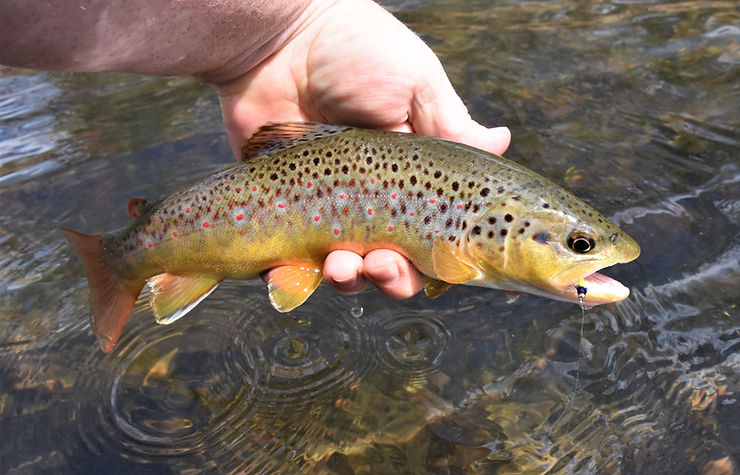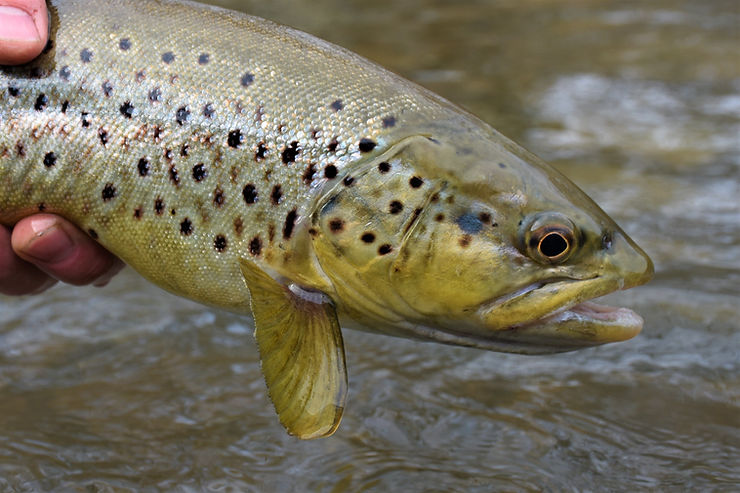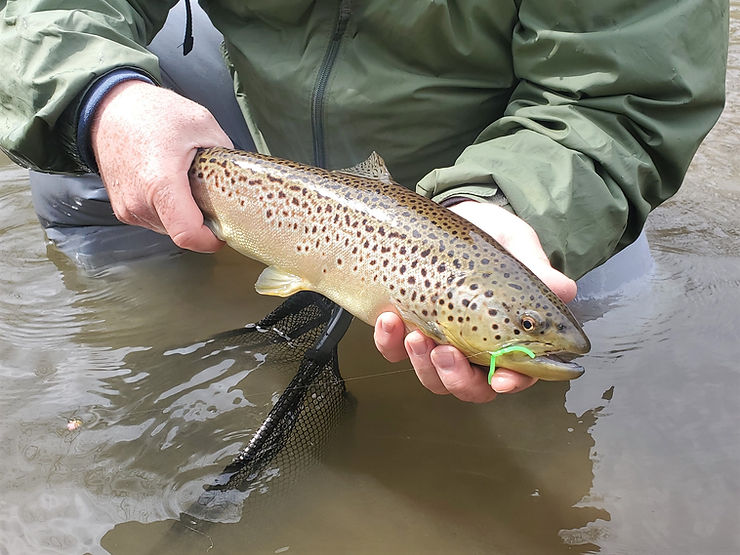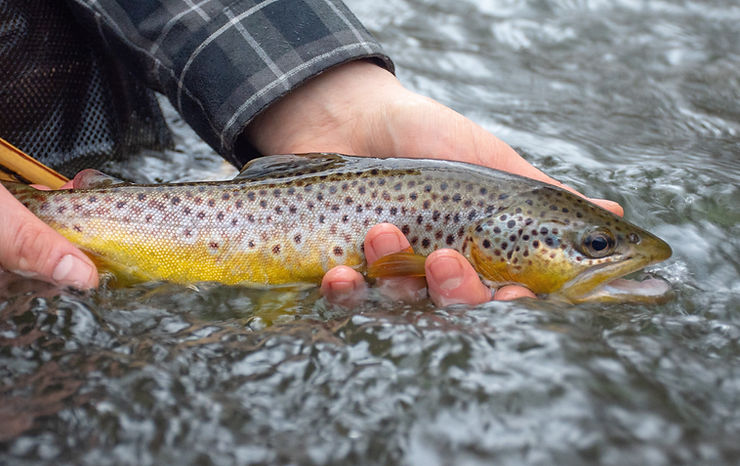Wild Brown or Stocked? Know the Difference

Scroll through many fly fishing forums on social media and you’ll soon see someone who has posted a trout photo and asked if it was a wild or stocked brown. If you want a good laugh, read the responses. Many times, the answers will be split 50/50, which leads me to believe that most people just don’t know the difference.
And to be honest, it can sometimes be very difficult to tell. The Pennsylvania Fish & Boat Commission, as well as other state agencies and hatcheries that raise trout, have gotten quite good at the process and they stock some beautiful looking browns.
Also keep in mind that no two trout streams are the same, and there can be a lot of variance in how a wild trout from one creek looks compared to a wild trout from another. There’s really no single thing you can point to that will signify a wild fish, but when you consider the six elements provided here, you’ll be well on your way to being able to differentiate a wild from a stocked brown trout.
1. Where It Was Caught
This is the most obvious one, but still not a guarantee because some trout are very migratory and can travel miles in a relatively short period of time. Many times, I’ve caught stocked rainbows where the closest stocked stream was miles away. Regardless, location is a major clue to whether you’re looking at a wild or stocked fish.
2. The Black Spot Behind The Eye
This one is a definite and you can take it to the bank. If a brown trout has a black spot behind the eye, then that fish was born in the stream. However, not all streambred browns have a black spot — some don’t even have a bluish spot/halo — which is why you have to consider all factors before making a judgment.
Disclaimer: Mother Nature can be fickle. As soon as I claim that something is “definite” or 100% certain, I know someone will show me that 1-in-a-million variation that makes me look like a fool, and I’m okay with that. And that’s also why I’m suggesting to never look at to one trait as proof that a trout is wild or stocked. Rather, taking all of the elements mentioned here into consideration will help you come to a reasonable conclusion about a trout’s origin.

3. Blue Behind The Eye
This one is a “sometimes true” statement and can apply to both a streambred trout and a holdover trout. The longer fish are in a stream, the more they change. One of those changes is the bluish spot behind the eye, which signals a holdover trout — one that was originally stocked as either an adult or fingerling and has lived one or more years in the stream. I’ve also seen trout start to develop this bluish halo in as little as 6-8 weeks after stocking.

Catch More Trout With An Exclusive Discount For Our High Quality Flies
Use the promo code 25OFF at checkout!
Shop Now4. The Condition Of Its Fins
Hatchery-reared trout get beat up in the raceways where they live and in the truck on the way to the stream. Their fins sometimes grow in a distorted manner or appear very thick and almost rubbery. Wild trout generally have near perfect fins that appear very thin around the edges.

5. Coloration
A stocked brown has many gray tones throughout its flanks and belly. A wild brown exhibits more vivid colorations, yellowish belly, bright red spots, a red-tipped adipose fin, and sometimes even red-lined tail fins. The trout in the lead photo at the top of this post displays all of these markings of a wild brown, and it most certainly is a wild brown. However, don’t rely on just a red-tipped adipose fin to identify a wild trout. Even stocked fish will start getting that coloration within a few months or even weeks of stocking. So you have to look at the overall coloration of the fish, not just one part. In fact, coloration is the least reliable way (in my opinion) to identify a wild brown trout, although it can be a key indicator between native and stocked brook trout and wild or stocked rainbow trout. But when it comes to brown trout, don’t base it off of color alone.

6. Fat Content And Shape
Wild trout are generally firm and lack the “pot belly” of stocked fish that have been fed high-fat diets that helped them grow so fast in the hatcheries. With that said, though, the fattest wild browns I’ve ever seen were from Spring Creek near Bellefonte. Those fish must eat incredibly well! But as a general rule, wild trout aren’t that robust.

If you have other suggestions about what to look for to determine a wild brown versus stocked, I’d appreciate your feedback in the comments section below.
This one is a “sometimes true” statement and can apply to both a streambred trout and a holdover trout. The longer fish are in a stream, the more they change. One of those changes is the bluish spot behind the eye, which signals a holdover trout — one that was originally stocked as either an adult or fingerling and has lived one or more years in the stream. I’ve also seen trout start to develop this bluish halo in as little as 6-8 weeks after stocking.
Did You Find This Guide on Identifying Wild or Stocked Trout Helpful?
Stay up to date with the Dark Skies Fly Fishing monthly newsletter for free and receive the latest fly fishing guides, news, tricks, tips, and techniques, stream reports, as well as updates on new flies added to the Online Store and exclusive discounts!
Sign Up Now
Another factor is at what point is a trout considered wild? Some trout may have started out as a planted fish but live so long in a stream that they become “wild” or is the offspring of a planted trout now a wild trout because it was born in the stream instead of the hatchery.
#browntroutatllanticsalmonnexus
Are stocked trout’s fins ever clipped?
Not always. I’ve heard people talk about that quite a bit, and maybe sometimes they are, but there are plenty of stocked trout out there with perfect fins. Also, I’ve been on numerous stream surveys with biologists who always clip fins when they electroshock a stream so that they know which fish they’ve counted in case they return to do a second survey.
And when I say they clip the fins, they’re just nipping off the tiniest sliver off their tail fin. It’s not drastic and doesn’t impact them in any way. I’d guess most people wouldn’t even notice it.
the “near perfect specimen” looks identical to some holdovers and ive caught some the day the stocked that look identical. coloration has more to do with environment and seasons.
Thank you for your comment. Can’t say I’ve ever caught any fresh stockers that look like the trout you’re referring to, except for slight coloration similarities. But that’s also why you can’t just look at color to determine stocked from wild. You have to look at multiple factors to be able to make a judgment…and even then, it’s just that. A judgment call.
The point of this article is to provide a set of guidelines that people can reference in their decision making. Too many people look at just one aspect and fail to see the bigger picture.